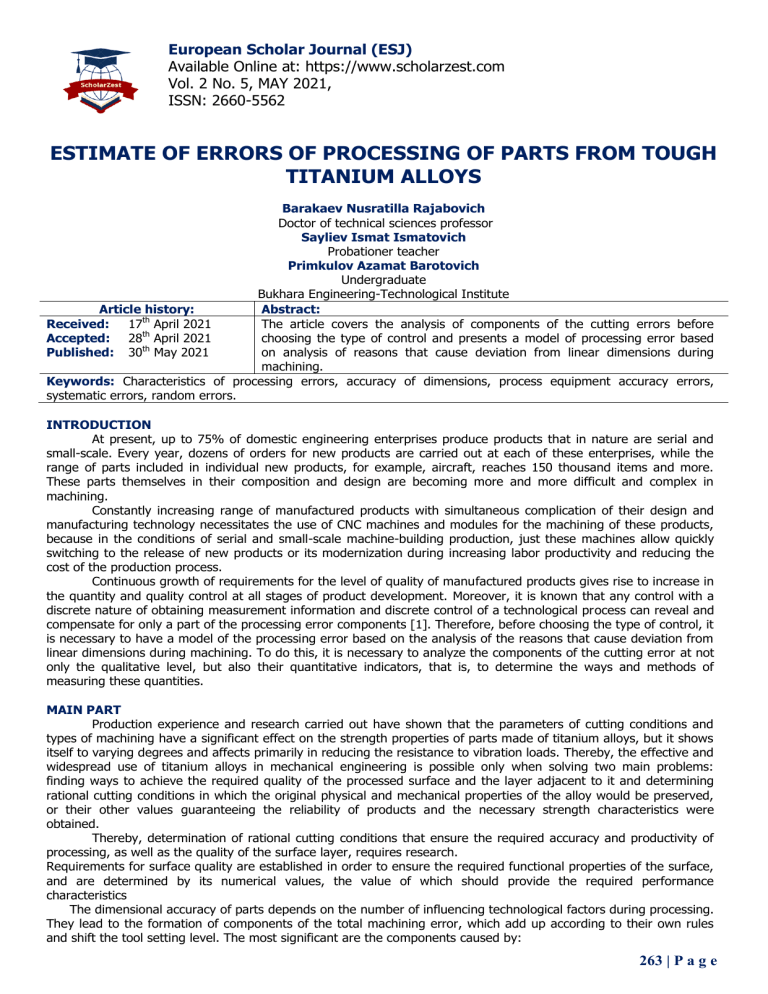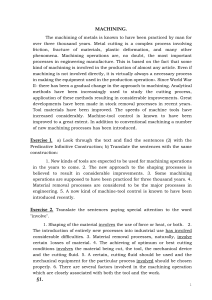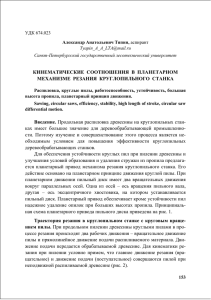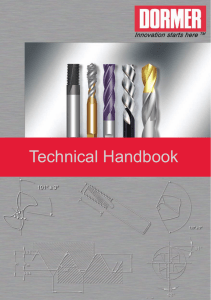
European Scholar Journal (ESJ) Available Online at: https://www.scholarzest.com Vol. 2 No. 5, MAY 2021, ISSN: 2660-5562 ESTIMATE OF ERRORS OF PROCESSING OF PARTS FROM TOUGH TITANIUM ALLOYS Barakaev Nusratilla Rajabovich Doctor of technical sciences professor Sayliev Ismat Ismatovich Probationer teacher Primkulov Azamat Barotovich Undergraduate Bukhara Engineering-Technological Institute Article history: Abstract: Received: 17th April 2021 The article covers the analysis of components of the cutting errors before Accepted: 28th April 2021 choosing the type of control and presents a model of processing error based Published: 30th May 2021 on analysis of reasons that cause deviation from linear dimensions during machining. Keywords: Characteristics of processing errors, accuracy of dimensions, process equipment accuracy errors, systematic errors, random errors. INTRODUCTION At present, up to 75% of domestic engineering enterprises produce products that in nature are serial and small-scale. Every year, dozens of orders for new products are carried out at each of these enterprises, while the range of parts included in individual new products, for example, aircraft, reaches 150 thousand items and more. These parts themselves in their composition and design are becoming more and more difficult and complex in machining. Constantly increasing range of manufactured products with simultaneous complication of their design and manufacturing technology necessitates the use of CNC machines and modules for the machining of these products, because in the conditions of serial and small-scale machine-building production, just these machines allow quickly switching to the release of new products or its modernization during increasing labor productivity and reducing the cost of the production process. Continuous growth of requirements for the level of quality of manufactured products gives rise to increase in the quantity and quality control at all stages of product development. Moreover, it is known that any control with a discrete nature of obtaining measurement information and discrete control of a technological process can reveal and compensate for only a part of the processing error components [1]. Therefore, before choosing the type of control, it is necessary to have a model of the processing error based on the analysis of the reasons that cause deviation from linear dimensions during machining. To do this, it is necessary to analyze the components of the cutting error at not only the qualitative level, but also their quantitative indicators, that is, to determine the ways and methods of measuring these quantities. MAIN PART Production experience and research carried out have shown that the parameters of cutting conditions and types of machining have a significant effect on the strength properties of parts made of titanium alloys, but it shows itself to varying degrees and affects primarily in reducing the resistance to vibration loads. Thereby, the effective and widespread use of titanium alloys in mechanical engineering is possible only when solving two main problems: finding ways to achieve the required quality of the processed surface and the layer adjacent to it and determining rational cutting conditions in which the original physical and mechanical properties of the alloy would be preserved, or their other values guaranteeing the reliability of products and the necessary strength characteristics were obtained. Thereby, determination of rational cutting conditions that ensure the required accuracy and productivity of processing, as well as the quality of the surface layer, requires research. Requirements for surface quality are established in order to ensure the required functional properties of the surface, and are determined by its numerical values, the value of which should provide the required performance characteristics The dimensional accuracy of parts depends on the number of influencing technological factors during processing. They lead to the formation of components of the total machining error, which add up according to their own rules and shift the tool setting level. The most significant are the components caused by: 263 | P a g e European Scholar Journal (ESJ) ____________________________________________________________________ - thermal deformations of the elements of machine tool and cutting tool of the part; - Inaccuracy of the technological scheme of processing. elastic deformations of technological system; dimensional wear of cutting tool; errors in setting the tool to size, which include components caused by geometric errors of the machine; measurement errors; instability of the properties of blanks. Errors arising because of basing and fixing the blank, due to imperfection of the technological process associated with the route of processing parts, the choice of cutting modes, etc. When developing this method, they are not considered, since most of these errors can be reduced or eliminated when creating a technological process. In order to ensure the accuracy of machining, it is necessary to create a mathematical model of the occurrence of error depending on the parameters of the technological process. Based on this model, it is possible to choose rational cutting conditions that ensured the minimum processing error. Based on the current requirements of the processing technology of parts, there are two approaches to creating mathematical models of the change in error. Approach 1. The accuracy characteristics of technological equipment (CNC machines or modules) are tested, statistical activities are carried out on it for processing blanks, after which a model is created for certain processing conditions. Approach 2. Special experimental setup is being created, capable of accumulating a large amount of information about the input and output parameters during the cutting process, processing this information, designing models depending on the cutting conditions and the prevailing components of the processing error; check these models by computational and experimental methods, and then recommend their use with reference to specific recommended equipment, where they will give the maximum effect in obtaining the maximum possible processing accuracy. Further, based on these models, a methodology for error estimate in cutting is formed. On its basis, a preliminary calculation of the accuracy of the technological process is made in order to assess its capabilities, and the tendency of changes in the processing error and its further compensation is investigated. The main reasons for the occurrence of machining errors during turning [2] are given below. Geometric inaccuracy of the machine in unloaded state. Inaccuracy of the measuring profile tool. Wear of the cutting tool. Elastic deformations of the technological system and the gaps between its links. Thermal deformations of the tool, part and machine. Inaccuracy in setting the machine to size. Deformations under the influence of internal stresses arising in the metal in the process of obtaining blank or during its processing. Inaccuracy of the measuring tool. Let us consider the wear of the cutting tool and its thermal deformation in more detail. According to the method of professor Sokolovsky A.P. [3], the errors caused by the wear of the cutter during turning can be calculated by the formula: (1) U = 2uL/1000 Where: U is regularly varying error caused by cutter wear, micron; u is the relative wear of the cutter, micron; L is cutting path when turning, km. The cutting path L is calculated using the formula: L Dl/(1000S), (2) Where: D is the diameter of the blank, mm; l is processing length, mm; S is cutter feed, mm/rev. - In order to determine the thermal deformations of the cutter in the process of turning, the following formula is used [4]: 264 | P a g e European Scholar Journal (ESJ) ____________________________________________________________________ Where: is lengthening of the cutter head, micron, corresponding to the moment of time ; m is maximum cutter elongation, micron, corresponding to the moment of achieved thermal equilibrium; e is base of natural logarithms; is heating time, min; 0 is the time of the onset of thermal equilibrium, min. 0 can be found by the formula: (4) 0 = 1 Where: m is the mass of the cutter head, kg; C is the heat capacity of the cutter; h1 is the heat transfer coefficient of the cutter when heated ; F is the sectional area of the cutter, m2. On average, the time for the onset of thermal equilibrium is from 12 to 20 minutes. m can be found by the formula: 0.75 0.5 m = С LP B t S) V /F, Where: LP,, is length of the working part of the cutter, approximately equal to the overhang of the cutter, mm ; 2 B is ultimate strength of the processed material, kg/mm , t is the depth of cut, mm; S is the feed, mm/rev; V is cutting speed, m/min. Analysis of methods for obtaining measurement information during cutting has led to the need to represent the components of the processing error, including: - obey. systematic permanent errors caused, for example, by the inaccuracy of the measuring instrument; systematic errors, regularly varying along the flow of the technological process, caused, for example, by dimensional wear of the cutting tool; random errors, which, appearing during the processing of one blank, do not necessarily appear during the processing of other blanks, and their values for different blanks vary within certain limits. It is possible to predict the moment of occurrence and the magnitude of these errors only with a certain probability. Systematic processing errors are studied using theoretical or experimental research of the laws to which they Random errors are studied using probability theory and mathematical statistics. This approach to the consideration of the total processing error allows estimating main reasons for its appearance and at the same time identifying that part of them, the influence of which can be reduced or eliminated (the systematic part of the error). Random errors at this stage of development of control means by control methods are not always removable [5]. Systematic components are described by equations relating its value to the cutting parameters in each case. Values of the systematic components are algebraically added considering the sign, and based on this sum, the diametrical processing error for each part is calculated. Random components are estimated based on empirical dependencies or experimentally, considering the laws of their distribution, are added according to Taylor principle. CONCLUSIONS Components of dimensional wear of the cutting tool are systematic and can be calculated beforehand. In most cases, just this component of the error gives the greatest value to total processing error. When turning tough alloys, according to preliminary data, the wear of cutting tool increases sharply, which leads to increase in the corresponding systematic error. Components caused by errors in setting the tool to size, which include components associated with the geometric errors of the machine, are random in nature and can be estimated only when examining certain equipment. Components of unstable properties of blanks are of a random nature, because the blanks are sent for processing in a random sequence, and their maximum value can be estimated beforehand. REFERENCES 1. Anukhin V.I., Makarova T.A. Capabilities of the master control. Leningrad: “Leningrad house of scientific and technical propaganda”, 1990, p. 30 2. Technology of mechanical engineering: in two books. Textbook for universities / Zhukov E.L., Kozar I.I., Murashkin S.L. and others; edited by S.L. Murashkin. 3rd edition, added. Moscow: Vyschaya shkola, 2008. 3. Sokolovsky A.P. Accuracy of machining and ways to improve it. Moscow: Mashgiz, 1951, p. 487. 4. Sokolovsky A.P. Calculations of processing accuracy on metal-cutting machines. Moscow: Mashgiz, 1952, p. 288. 5. Anukhin V.I., Makarova T.A. Compensation of turning machining errors at process automation. International scientific and practical conference “Science and technology: step into the future”. March 03-04, 2014. Prague, 265 | P a g e European Scholar Journal (ESJ) ____________________________________________________________________ Czech Republic. p. 30–39. 266 | P a g e











